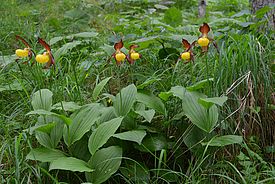05.04.2018 | News WSL
Nowadays, genetic methods can usefully be applied in nature conservation, e.g. to reveal where rare toads come from in order to mate or how strongly interconnected seemingly isolated populations of capercaillie are. A WSL symposium showed that genetics can provide important information on which to base decisions about protecting plant and animal populations.
Genetic variety is one of the three pillars of biodiversity, alongside species and habitat diversity. Effective measures to maintain biodiversity can only be taken if this diversity is known. Konrad Steffen, Director of the Swiss Federal Institute for Forest, Snow and Landscape Research (WSL), went even further at a symposium on genetics in nature conservation held in Birmensdorf, saying: "This young area of genetic research is producing findings that are playing a key role in decisions on nature conservation".
Today, genetic studies carried out within a context on species promotion and protection are often no costlier than other methods, emphasised Rolf Holderegger, Head of the WSL Research Unit Biodiversity and Conservation Biology. Indeed, in many cases these methods are the only ones available, e.g. for estimating how animals cover ground or establishing the connectedness of locally limited populations. For example, the migration of wolves and other animal species in Switzerland has been determined based on genetic analyses of their hair, faeces or saliva.
Genetic methods can tell us a great deal, but not everything
When building up reintroduced populations of bearded vultures, genetic methods can be used to determine the extent of inbreeding, which is important because excessive inbreeding will ultimately undermine a population's viability. In practice it is also important to know that plant and animal populations are not becoming too small and remain genetically diverse. However, Holderegger warned against getting carried away, adding: "Although genetic methods are now part and parcel of practical nature conservation and can do many things better than conventional methods, they still cannot do everything". In densely populated Switzerland, one question that regularly arises is whether certain elements of the landscape, such as roads, railway lines or rivers, constitute barriers for individual animal species, opening up endless possibilities for nature conservation studies. WSL biologist Janine Bolliger presented a study that compared the genetic data of natterjack toads with the migration patterns of 50 individuals fitted with tracking devices. While these telemetric data indicated that migratory movements tend to be local, genetic testing has demonstrated that even seemingly isolated populations interact with distant neighbours and are thus capable of mixing their genetic makeup. Bolliger summed this up by saying: "Kinship relationships are a good measure of the spatial interconnectedness of populations". Likewise, in Toggenburg (Canton of St. Gallen) WSL researchers found that local populations of the capercaillie are larger and their genetic diversity is greater than expected. So evidently this species manages to cover large distances and then reproduce, thereby exchanging its genes.
Gaps in practical applications
The still novel genetic methods of nature conservation, hitherto used mainly by research establishments, have not yet made the leap to being applied in practice everywhere. The importance of new methods can only be estimated based on specific questions investigated in the field, whereby the nature consultancies regionally anchored in many Swiss cantons have a local advantage, according to Conny Thiel-Egenter from FORNAT AG. That is why close collaboration between researchers and practical conservationists makes sense. One example cited by Thiel-Egenter is the lady's slipper orchid, which is supported by an action plan in the Canton of Aargau. The localities of the 18 distinctly separate populations of this endangered species of orchid should be given a higher standing and new populations should be established between them, so that genetic exchange can take place naturally. Another similar project on small populations concerns the Alcon blue, a rare butterfly that occurs on equally endangered lowland fens.
Since practical applications for nature conservation genetics have only recently been found, according to Thiel-Egenter there are still too few success stories, so most nature conservation authorities still probably lack confidence in genetic methods. "Moreover, genetic methods are not yet firmly established in the context of environmental impact assessments either, although they would be highly effective and thus important there", the biologist added.
Nature conservation impact assessments
The body of knowledge presented at the symposium on nature conservation genetics can merely be described as a snapshot, for the discipline is still young and making rapid inroads. Felix Gugerli, the ecologist who chaired the symposium, said it was impressive that after just a few years of application, today it is already possible to make specific use of genetic methods in nature conservation projects or to assess the success of previously implemented conservation measures in genetic terms. "The range of possible applications is becoming ever broader", Gugerli said. For example, in a time of climate change it is particularly important for conservation biology to consider endangered plant and animal species' potential to adapt to changing environmental conditions.
Contact ¶
Links and documents ¶
Copyright ¶
WSL and SLF provide image and sound material free of charge for use in press releases in connection with this media release. The use of this material in image, sound and/or video databases and the sale of the material by third parties is not permitted.

